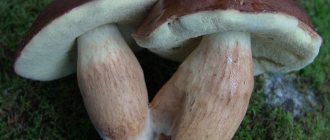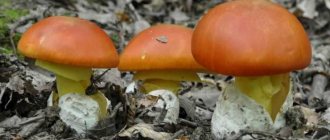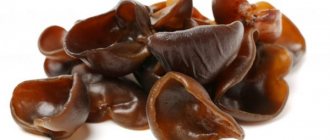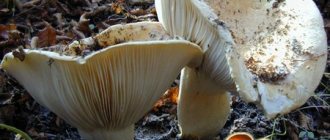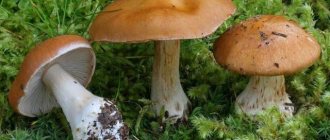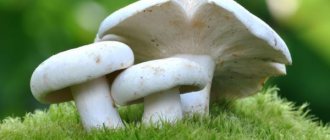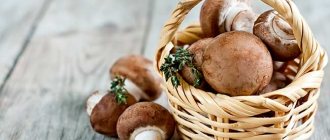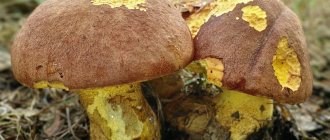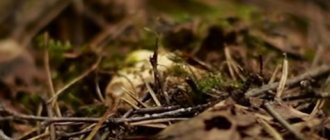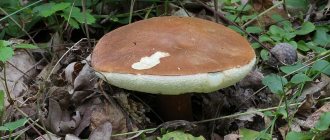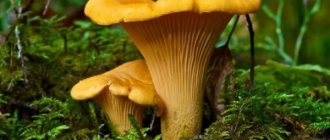Black milk mushrooms are unusual mushrooms in many respects. Their main distinguishing feature from their counterparts is the olive-black color of their caps. On this basis, they are endowed with a dozen different names - chernuka, gypsy, nigella, black hollow, black lip and others. From a scientific point of view, black milk mushrooms belong to the conditionally edible category of mushrooms. But mushroom pickers themselves value this type of milk mushroom for its unique aroma, excellent taste, long harvest season and abundance.
Place of growth
If you pay attention to the photo of black milk mushrooms, you will notice that these mushrooms prefer to settle at the roots of birch trees. Therefore, they can be found in deciduous or mixed forests of Russia, Ukraine, Belarus and some European countries.
The harvesting season for milk mushrooms is in August and September. However, these mushrooms can be found from late July to October.
Milk mushrooms love sunlight. Therefore, they are often located in families along paths or on forest edges.
Description of the mushroom
Black milk mushroom belongs to the genus of milkweeds of the Russula family, and has the Latin name Lactarius necator. In the common people it has quite a few names: olive-black, black spruce or olive-brown milk mushroom. There are also many nicknames: nigella or blackling, gypsy, pig-nosed, varen, black hollow or black lips. There are about eight Latin synonyms.
The cap of the black milk mushroom reaches 20 cm in diameter, the center is slightly depressed, sometimes funnel-shaped. The edge is turned inward. During the rainy season, mucus appears on the skin. The hat is dark olive. The pulp of the mushroom is quite dense and brittle. The color when cut is white, becoming grayish over time. An abundant milky juice is released, the taste of which is quite pungent.
The hymenophore of the mushroom, or the lower part of the cap, consists of frequent and thin plates that go slightly down the stem and have a forked-branched shape. The leg itself is low, reaching a maximum height of 8 cm, but thick – up to 3 cm in diameter. Closer to the ground it is slightly narrowed, smooth, slimy. It is lighter near the cap, then the color matches the upper part of the mushroom. Closer to the top it is dense, and towards the ground it is hollow. The cap of a black milk mushroom can be not only dark green, but also brown with a yellow tint or dark brown. The center is often darker than the edges.
The first to find and describe the characteristics of nigella was the French botanist and doctor Jean Baptiste François Pierre Bulliard in 1781, then he named the black milk mushroom Agaricus necator, and 5 years later classified it as Agaricus plumbeus.
Why are they classified as conditionally edible?
This group includes mushrooms that can be eaten after certain processing. Or having an unpleasant aftertaste that can be eliminated.
The toxin mutagen nekatorin was discovered in milk mushrooms. In fresh mushrooms its concentration is up to 20 mg/kg. After processing, it remains 4 times less, which does not lead to symptoms of poisoning.
However, you should not eat these mushrooms prepared in the wrong way. Milk mushrooms can be harmful to people with stomach problems. It is also dangerous to eat mushrooms collected within the city or in an environmentally polluted area.
False doubles
Among the false doubles, there are no truly those with which the nigella can be confused. For example, pepper and felt milk mushrooms have completely white caps. The camphor milkweed is reddish-brown, and the golden milkweed is light yellow. Apart from the camphor mushroom, which emits an unpleasant odor, the rest can be eaten, the main thing is to prepare it correctly and pre-soak it.
Interesting! The black hollow mushroom is a poisonous mushroom, but differs from the black milk mushroom in its beige color, and therefore it is impossible to confuse them.
An inattentive mushroom picker may confuse the pigtail with the black mushroom, but the differences between them are quite obvious. The latter has the following characteristic features:
Loader black
- hat with a gray tint;
- no milky juice;
- the pulp becomes reddish when cut;
- after touching the cut, the fruiting body takes on a black tint;
- strong moldy smell.
Pogruzdok is also considered a conditionally edible species and is soaked before salting. After salting it turns black. Stunted and rotten specimens should not be placed in a basket.
Use in cooking
Black milk mushrooms are included in many dishes. However, they should be soaked before use. To do this, the mushrooms are placed in a container with cold water, which is changed 3 times a day.
The procedure takes 3 days. This is enough to get rid of toxic substances. Afterwards it remains to drain the water and dry the product.
You can pickle milk mushrooms cold or hot. In the second case, before placing in the jar, the mushrooms are boiled for half an hour and infused in hot water for 20 minutes.
As a result, their readiness comes a month faster. Ready-made black milk mushrooms can be added to salads. Or use as a separate snack.
Let's summarize: there is no single view on black milk mushrooms. Some consider them hazardous to health due to the content of toxic substances.
Others value it for its medicinal properties and taste. Therefore, you can collect and cook these mushrooms while taking precautions.
Taste characteristics
Milk mushrooms are rich in protein, microelements, and vitamins. They are low in calories but high in nutritional value. They are not suitable for frying, but they are ideal for pickling. Even after prolonged processing, the flesh of the black milk mushroom remains elastic and dense, so it crunches on the teeth. These mushrooms retain their shape and always look beautiful on the table. They have a unique “mushroom” aroma, and the taste is rich and bright.
Milk mushrooms are considered dietary, so it is useful to include them in the diet of diabetics, athletes, and overweight people.
The best taste of black milk mushroom appears at the stage when the cap is still small and just beginning to form a funnel. At this moment, its edge part is still bent inward, and the plates are even and have a light shade. Large specimens accumulate the carcinogen necatorin and become bitter in taste. When attacking a large group, you should not be greedy. It is worth collecting only young representatives, and it is better to leave the old ones in the forest.
Photos of black milk mushrooms
Distribution and breeding season
Milk mushrooms live in the northern hemisphere. In the Ural and Siberian forests you can find an abundance of these mushrooms.
Chernushki have chosen places near coniferous and birch trees. Their growth begins in July and continues until October. Milk mushrooms bear fruit during cool periods.They are collected when the boletus leaves; there is no need to look for it earlier. Mushrooms belong to late varieties, as they can reproduce during the first frost.
They do not like heat and drought; if there is no rain in the summer, they do not germinate.
Hot salting
Let's start with the simplest method, hot salting. Bring the mushrooms to a boil, then remove with a slotted spoon. The water in which the foam remains is drained. Place the nigella into the pan again and fill it with fresh water. Add coarse rock salt in such an amount to obtain a sufficiently salty solution. Cook for about an hour, at the end of cooking add bay leaf, allspice and cloves. After cooling, remove the bay leaf. Transfer the mushrooms to a glass jar and add brine from the pan. You can add chopped dill and garlic. Place in a cool place (refrigerator). After 4 - 5 days, the mushrooms are ready. You can add chopped garlic to them. There are many variations of this recipe. When preparing mushrooms for pickling, I cut them into pieces, only adding very small mushrooms whole. There are mushroom lovers who pickle whole nigella mushrooms, even the largest ones. In all cases, it turns out delicious.
There is another option for salting nigella using a hot method. Drain the boiled mushrooms in a colander and place them in a bucket or pan with their caps down. Sprinkle the layers with salt (2 - 3 tablespoons per 1 kg of mushrooms). Then they are covered with a cloth, on which a wooden circle or plate of suitable diameter is placed and pressed. After 2 weeks, the nigella are salted and become very tasty.
Collection rules
Finding this species among fallen leaves, spruce needles and forest soil is difficult, especially for a novice mushroom picker. The specific color of the cap and low stem allow it to cleverly hide in the grass or fallen leaves.
If you can find at least one copy, the collection will be successful. You need to look closely nearby - usually black milk mushrooms grow in groups.
Clearings covered with moss are favorite places for mushrooms to grow. Black milk mushrooms are also collected from old log houses, along forest paths.
The mushroom grows in the same place year after year.
Beneficial features
The benefit of black milk mushroom lies in its rich composition, which includes:
- vitamins;
- folic acid;
- amino acids;
- vegetable protein;
- antioxidants;
- calcium;
- selenium.
In addition to the dietary effect, it was noted that the introduction of nigella into the diet significantly strengthens the immune system and heart muscle, improves and stabilizes mood, improves memory and attention. Minor skin damage begins to heal faster, which is important for diabetics.
Contraindications
Mushrooms can be eaten in small quantities
The most serious are exacerbations of gastrointestinal diseases and individual intolerance to the product.
You should know: the pulp of mushrooms is difficult to break down, so a large amount eaten at one time can result in an upset stomach, vomiting and fever.
How fast they grow
In order for the fruiting body to grow, 7-10 days must pass after the rain. The entire life cycle is about 14 days.
Depending on the region and the temperature of the top layer of soil, the mycelium bears fruit from mid-August to early October. In September, the conditions are most suitable: rain and sufficient sun.
andrei_forester
maharynski
